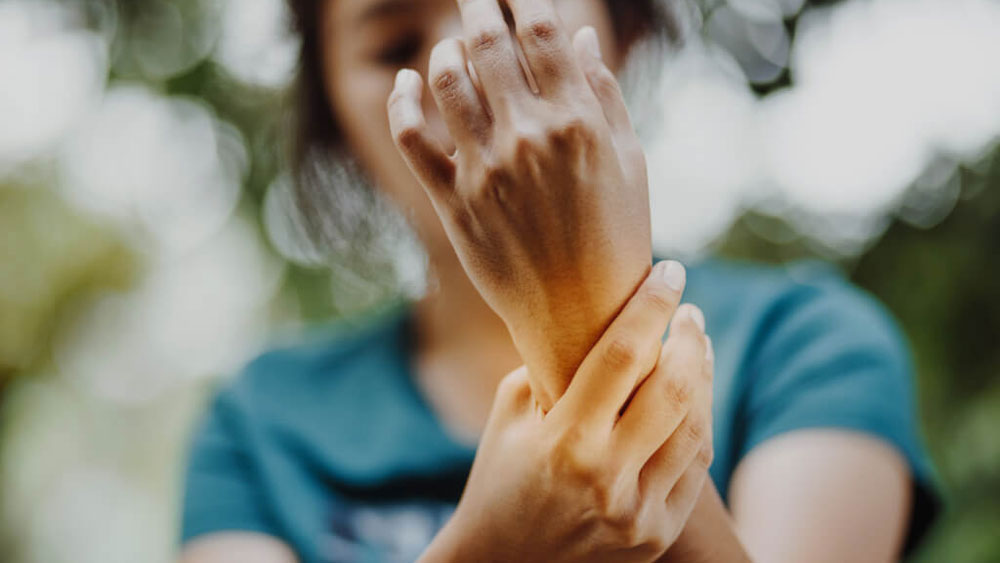How do hands work?
Hands have a very delicate and complex structure. This gives muscles and joints in the hand a great range of movement and precision. The different forces are also distributed in the best possible way. Thanks to this structure, you can do a wide range of things with your hands, such as grip objects tightly and lift heavy weights, as well as guide a fine thread through the tiny eye of a needle.
Hands are also quite vulnerable, though: Tendons, nerve fibers, blood vessels and fairly thin bones are all positioned right under the skin and are only protected by a thin layer of muscle and fat. Only the palm is protected by a strong pad of tendons (aponeurosis), enabling a powerful grip. Our hands are put through quite a lot every day, and often come into contact with potentially harmful objects. As a result, hand injuries and problems due to wear and tear are very common.
The right and left hand are each controlled by the opposite side of the brain. Usually one hand is preferred for carrying out fine and complex movements, so we often say people are either right- or left-handed.
Bones and joints
The human hand is made up of a total of 27 individual bones: 8 carpal bones, 5 metacarpal bones and 14 “finger bones” (also called phalanges) are connected by joints and ligaments. About one quarter of all our body’s bones are found in our hands. The hand can be divided up into three different areas based on the joints:
-
Carpus (wrist bones)
-
Metacarpus
-
Fingers
Wrist
The wrist is made up of two parts of a joint that work as one functional unit. It allows us to flex (bend) or extend (stretch) our hands. We can also tilt our hands sideways, towards our little finger or thumb.
Carpus
The eight carpal bones are held together tightly by ligaments, and are more or less fixed in place. They are positioned in two rows of four carpal bones each. Together with the radius bone in the forearm, two of the carpal bones (the scaphoid bone and the lunate bone) form the lower part of the wrist joint, which is very important for hand movements. The ulna bone in the forearm is separated from the carpal bones by a cartilage disc. The other part of the joint is located between the two rows of carpal bones.
Metacarpus
After the second row of carpal bones comes the metacarpus. This middle part of the hand consists of five long metacarpal bones. You can feel them quite clearly on the back of your hand. One of the carpal bones and the long thumb bone come together to form the basal joint of the thumb. Known as the carpometacarpal joint, it enables the thumb to be particularly flexible.
Fingers
The freely movable part of our hand is made up of five digits (four fingers and one thumb). Each finger has three individual bones, and the thumb only has two. The fingers have three joints each, which can only be bent and stretched in one direction. The thumb is the only digit that can twist, thanks to the saddle-shaped carpometacarpal joint.
Muscles
There are over 30 muscles in the hand, working together in a highly complex way. Movements of the hand are mostly started by muscles in the forearm. Only the thin tendons of these muscles are found directly in the hand: the extensor tendons used for stretching the hand run through the back of the hand to the tips of the fingers, and the flexor (bending) tendons run through the palms to the fingers.
Short muscles of the hand
There are short muscles between the individual metacarpal bones of the hand. They allow us to spread our fingers (abduction) and then pull them back together (adduction). They also help to bend and stretch the fingers.
The thenar eminence and the hypothenar eminence muscles
Two groups of more powerful muscles in the hand itself make up the thenar eminence (at the base of the thumb) and the hypothenar eminence (controlling the movement of the little finger). Among other things, the thenar muscles enable the thumb and the tips of the four fingers to touch each other (opposable thumb). A separate muscle (the adductor pollicis) is used to pull the thumb towards the palm. The hypothenar eminence muscles are mainly used for mainly used for sticking out the little finger and pulling it inwards again, and for tightening the skin that covers the hypothenar eminence.
Lumbricals
The lumbricals of the hand are four thin, worm-like muscles that help bend the metacarpophalangeal joints and extend the fingers.
Connective tissue and tendons
Some parts of the long flexor and extensor tendons of the forearm muscles are surrounded by protective layers called tendon sheaths. Tendon sheaths contain a fluid that acts as a lubricant. This allows the tendons to slide smoothly through the sheaths, without friction.
Muscle tendons, nerves and blood vessels running from the forearm to the hand pass through a tunnel-like passageway on the palm side of the wrist. Known as the carpal tunnel, this passageway is made up of strong connective tissue and carpal bones.







